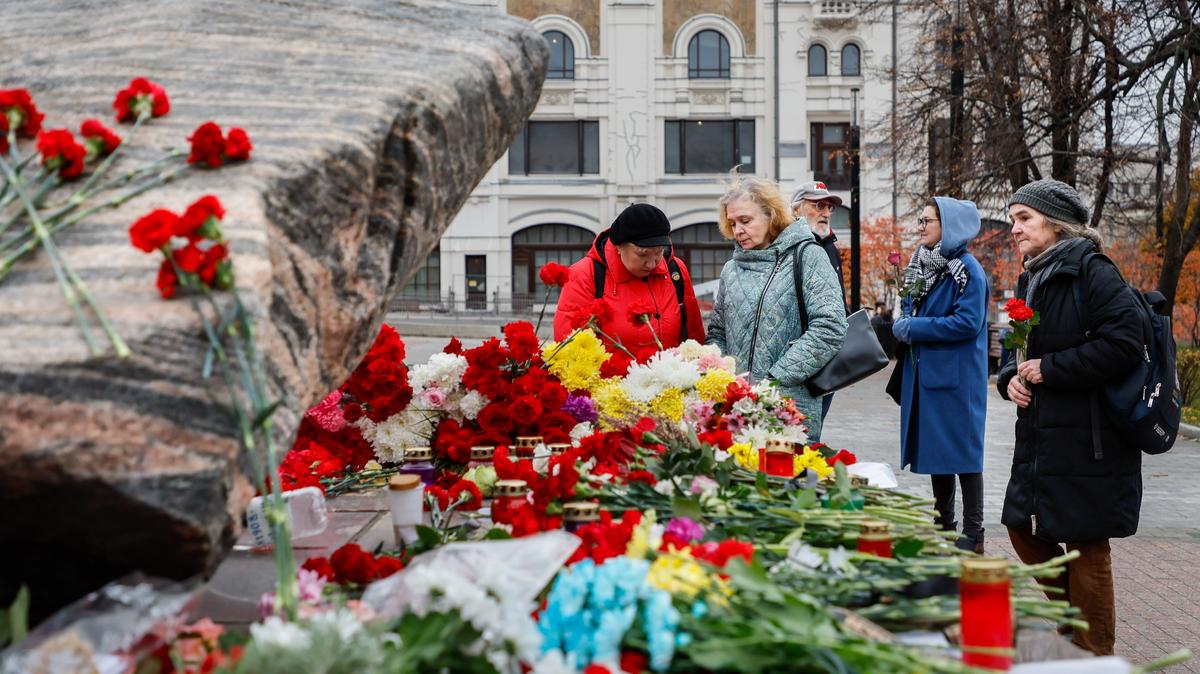Despite the increasingly aggressive attempts by the Russian authorities to intimidate and hinder any attempts to publicly mourn the victims of the country’s 20th century past, on 29 October thousands of people in 19 Russian cities took part in an annual ritual known as Restoring the Names, in which they read aloud lists of those liquidated by the Soviet state.
Created to ensure the names of those executed by the communist authorities were not forgotten, these public acts of memorial have been taking place since 2007, coordinated by international human rights organisation Memorial.
For the fifth year in a row, the Moscow authorities banned the ceremony from taking place at the Solovetsky Stone, a slab of granite transported from the site of the Soviet government’s first prison camp in Russia’s far north that now stands outside the notorious Lubyanka prison in central Moscow. While officially the event was cancelled due to Covid-19 restrictions, the fact that the authorities also went to the trouble of blocking the event’s website suggests that there may have been far more behind the move.
Since Russia’s invasion of Ukraine there have been growing indications of even more entrenched opposition to the memorialisation of past political repression. For example, memorial plaques installed in Moscow, St. Petersburg and Perm by nonprofit organisation Last Address have been vanishing since summer 2023.
Inspired by Germany’s Stolpersteine project, which places brass plaques engraved with the biographical data of Holocaust victims into the pavement outside their last known residence, Last Address, founded in 2014, has been doing the same in Russia for the past decade. Despite being both minimalist and relatively few in number, however, hundreds of the plaques have subsequently been removed.
Novaya Gazeta Europe asked Alexander Cherkasov, the former chair of Memorial, to explain why the Russian authorities are so determined to prevent people remembering the past and why it is so important to stop that happening.
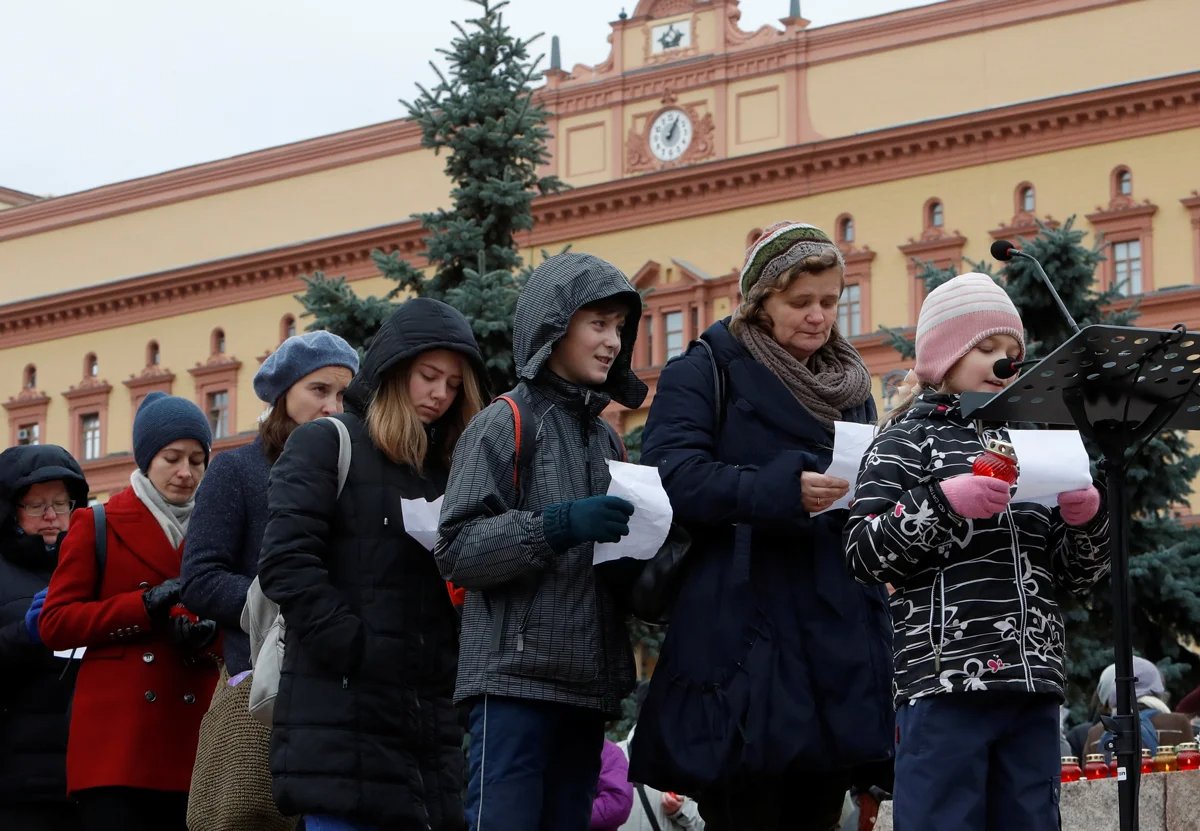
Participants stand in line to read the names of victims of repression, Moscow, 29 October 2018. Photo: Sergey Karpukhin / Reuters / Scanpix / LETA
“I’d like to name you all by name, but the list has been removed and there is nowhere else to look,” Russian poet Anna Akhmatova wrote in Requiem, the elegy for Stalin’s victims that she began writing at the height of the Great Terror. Soviet activists later came up with the concept of Restoring the Names as means of resistance, pushing back against official efforts to erase names from the collective memory, names that future generations might otherwise never know.
After its founding in 1987, Memorial quickly became the largest social movement of the early perestroika period, its core belief being that without first understanding Russian history, it would be impossible to understand the country’s present or to determine its future.
Despite the 1991 adoption of legislation that required the Russian authorities to throw open its previously closed archives and make publicly available information about the victims of state repression, there was much official hesitation to actually do so.
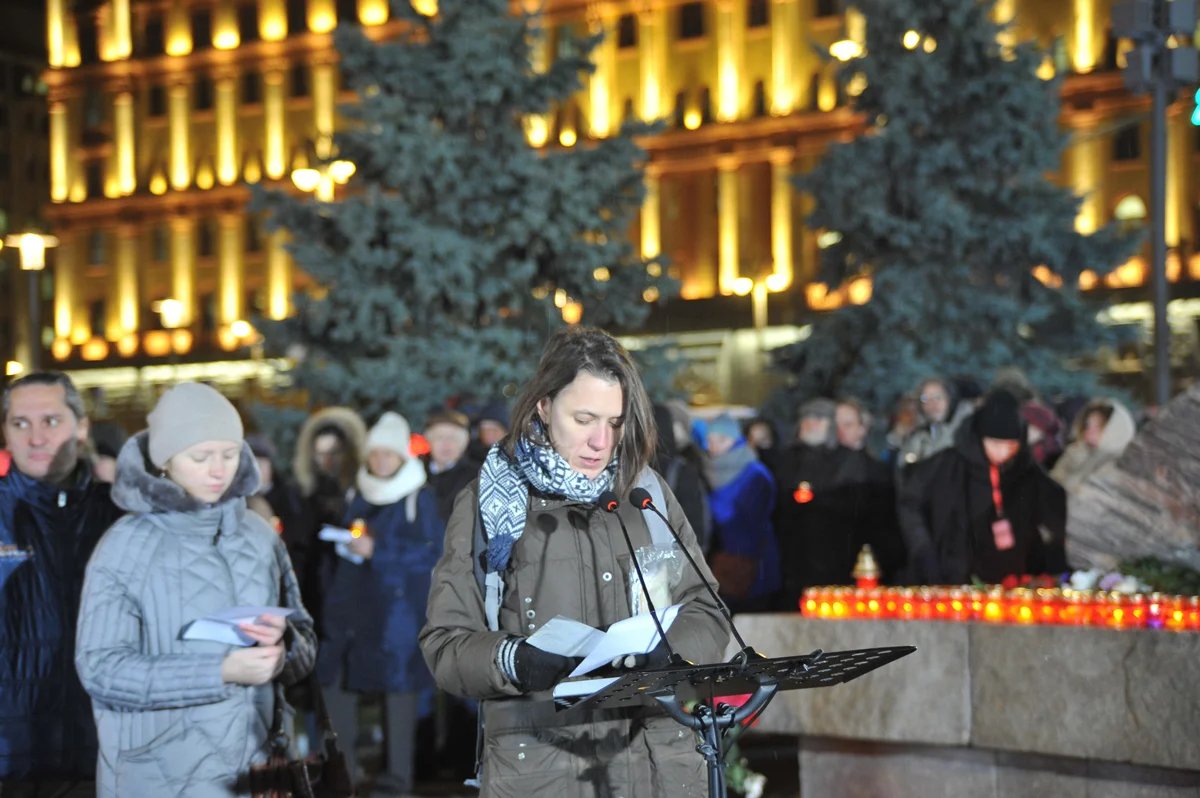
The Restoring the Names ritual is held on Lubyanka Square in Moscow, 29 October 2018. Photo: Efim Grosman / Alamy / Vida Press
Coming to terms with the Soviet past was not a priority for the Russian state in the 1990s, after all, and it was for the most part totally indifferent to the memorial initiatives being pioneered by the civil society groups that had sprung up once political pluralism had been introduced.
However, once Vladimir Putin ascended the throne in 2000, history and symbolism found themselves rapidly back in the Kremlin’s crosshairs. Nevertheless, the process of documenting and memorialising Russia’s 20th century history continued: books were published; a database of victims which currently contains over 3 million names was created; and a museum was set up on the site of the last Soviet camp for political prisoners at Perm-36, while the virtual gulag museum collated past Russian museum exhibitions on the history of political repression.
But all of these initiatives lacked the crucial element of ritual, which was eventually provided first by Restoring the Names, which started in 2007, and then by Last Address seven years later. At such events, people read out a victim’s full name, their date of birth, their profession, when they were arrested, when they were executed, and — finally — when they were rehabilitated.
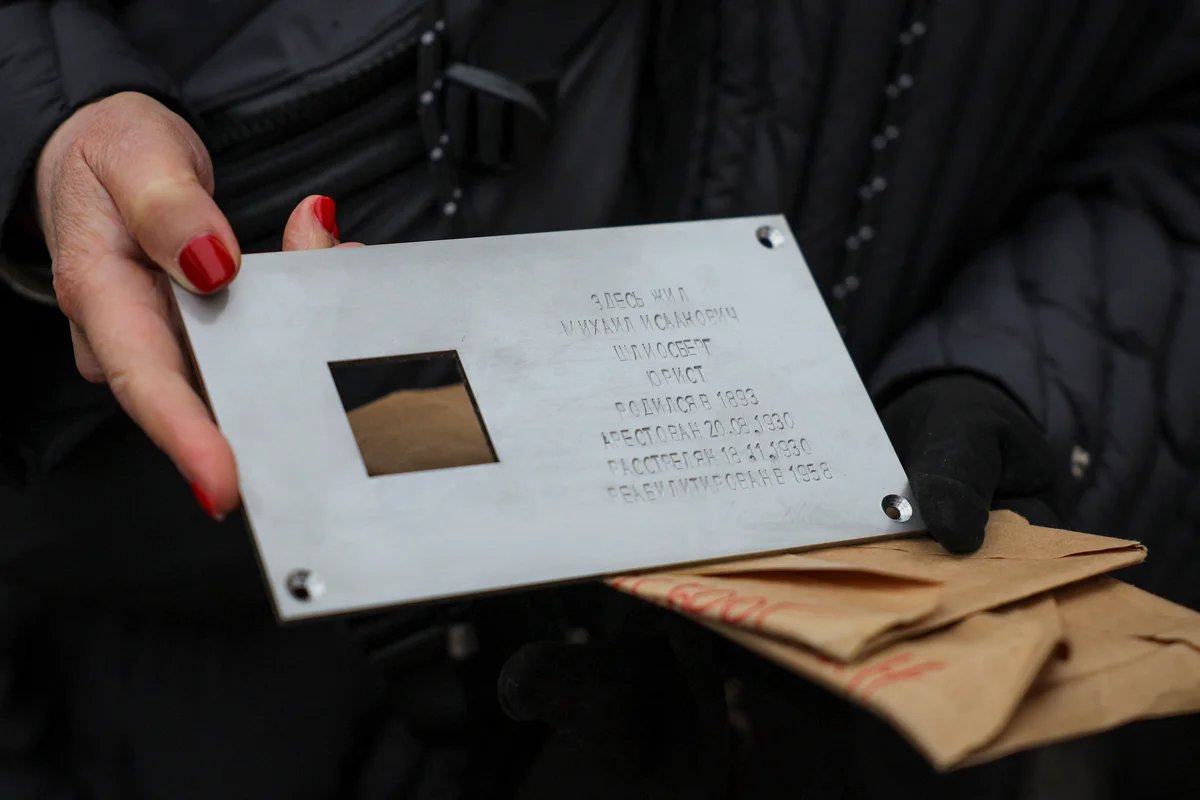
Plaque in memory of Mikhail Shliosberg, executed in 1930 and rehabilitated in 1958, Moscow, Russia, 29 October 2023. Photo: Yevgenia Novozhenina / Reuters / Scanpix / LETA
During the Soviet era, 30 October became the unofficial Day of the Political Prisoner, a concept dreamt up in 1974 by journalist Kronid Lyubarsky, himself a dissident human rights activist and political prisoner himself at the time.
From 1991 on, once 30 October had been established as the official Day of Remembrance of the Victims of Political Repression, Restoring the Names activists decided to read out the names of terror victims at the Solovetsky Stone the day beforehand. Participants would be given sheets of paper with two or three names written on them before lining up to place candles at the Solovetsky Stone, after which they would read out the names they had been given, often adding those of their own relatives and even those of contemporary political prisoners too.
After the authorities refused permission for the event to go ahead in 2020, citing Covid-19 restrictions, Restoring the Names went online, where it has been held in Russia ever since. However, in dozens of other countries around the world the public ritual of remembrance continues, and is used to both honour the memory of past victims of totalitarianism and to express solidarity with contemporary political prisoners.
Describing Soviet-era repression as state terror directed against its own citizens was always taboo, even though that’s exactly what it was.
Access to the livestream of the event may have been blocked in Russia by media regulator Roskomnadzor, but in the third year of the war in Ukraine, enough people have learnt how to bypass such blocks to ensure that disabling access to a website falls far short of actually stopping the event itself.
One of the contemporary Russian state’s main objectives is to destroy solidarity between members of the population, a goal that has so far gone unrealised judging by the number of people who turned out to accompany Alexey Navalny on his final journey in March. Fearing they would be few in number, making it all the more important for them to go out and be seen, they in fact turned out in their tens of thousands.
While until recently remembering the past hadn’t been banned as such, there were always unwritten rules to observe. For the current Russian government, acts of remembrance must always be carried out in the “correct” manner.
For one thing, describing Soviet-era repression as state terror directed against its own citizens was always taboo, even though that’s exactly what it was. In addition to that, the Kremlin demands that acts of remembrance must be focused entirely on the past, and should in no way become a cause for reflection on — or comparison with — the present.
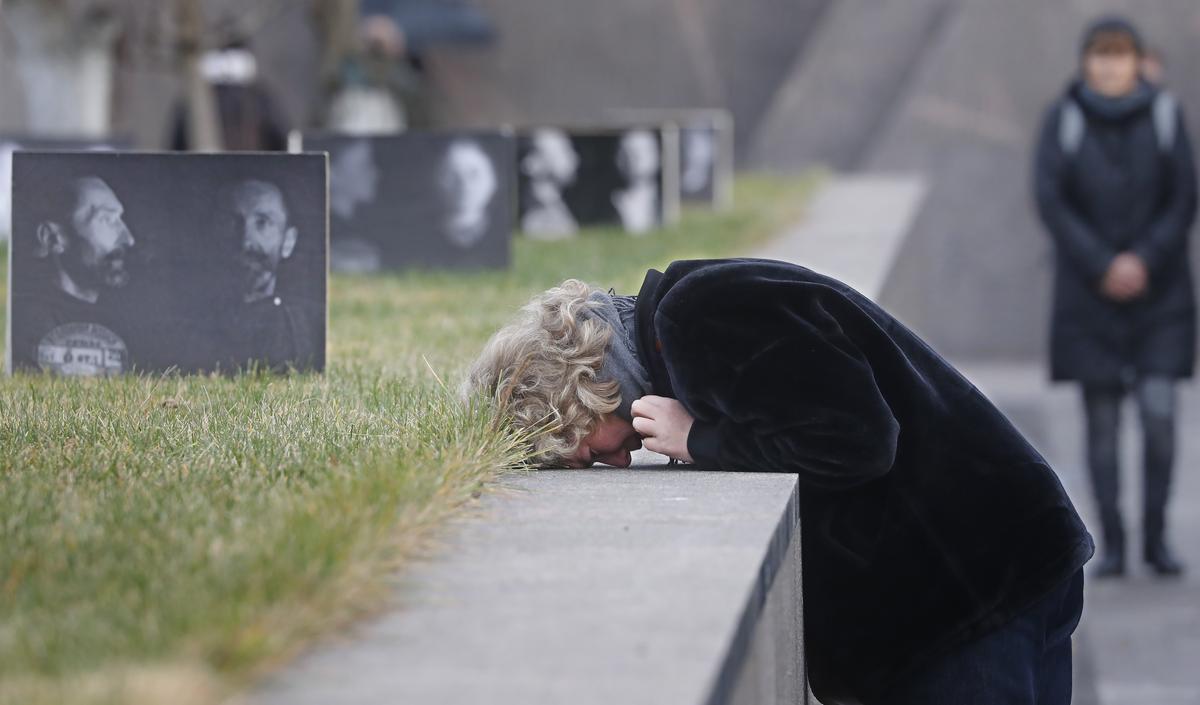
Visitors to the memorial walls at the Butovo Firing Range outside Moscow, where some 20,762 people were executed during Stalin’s Great Terror in 1937-1938. Photo: EPA-EFE / MAXIM SHIPENKOV
Another peculiarity of Russian remembrance culture lies in the fact that only the rehabilitated victims of repression are deemed worthy of commemoration. Those accused of anti-Soviet resistance, particularly of the armed variety, have never been rehabilitated, and are, as a result, effectively forgotten.
Those who engaged in resistance in Ukraine or Lithuania at the end of World War II, for example, or anyone joining the 1921 Kronstadt rebellion, in which sailors and naval officers rose up against the Bolshevik authorities in Petrograd, remain anathema to a state that never forgives its own citizens when they dare to fight for freedom.
Perhaps most important, however, is the fact that remembering the victims of Soviet-era terror has for some reason become compartmentalised. Instead of recognising the victims of Soviet terror as a whole, far smaller and more palatable victim subsets are remembered, whether it be those who died in the siege of Leningrad, collectivisation, or the Holodomor.
Had the remembrance of Soviet terror as a whole been allowed to enter the Russian collective consciousness from the very beginning, it might have formed the foundation of a politically engaged modern state able to view its own past clearly. But Russia’s memory of the 20th century remains torn and broken, and the urgency to repair it is far less about overcoming the past than it is about forging the future.
Join us in rebuilding Novaya Gazeta Europe
The Russian government has banned independent media. We were forced to leave our country in order to keep doing our job, telling our readers about what is going on Russia, Ukraine and Europe.
We will continue fighting against warfare and dictatorship. We believe that freedom of speech is the most efficient antidote against tyranny. Support us financially to help us fight for peace and freedom.
By clicking the Support button, you agree to the processing of your personal data.
To cancel a regular donation, please write to [email protected]
